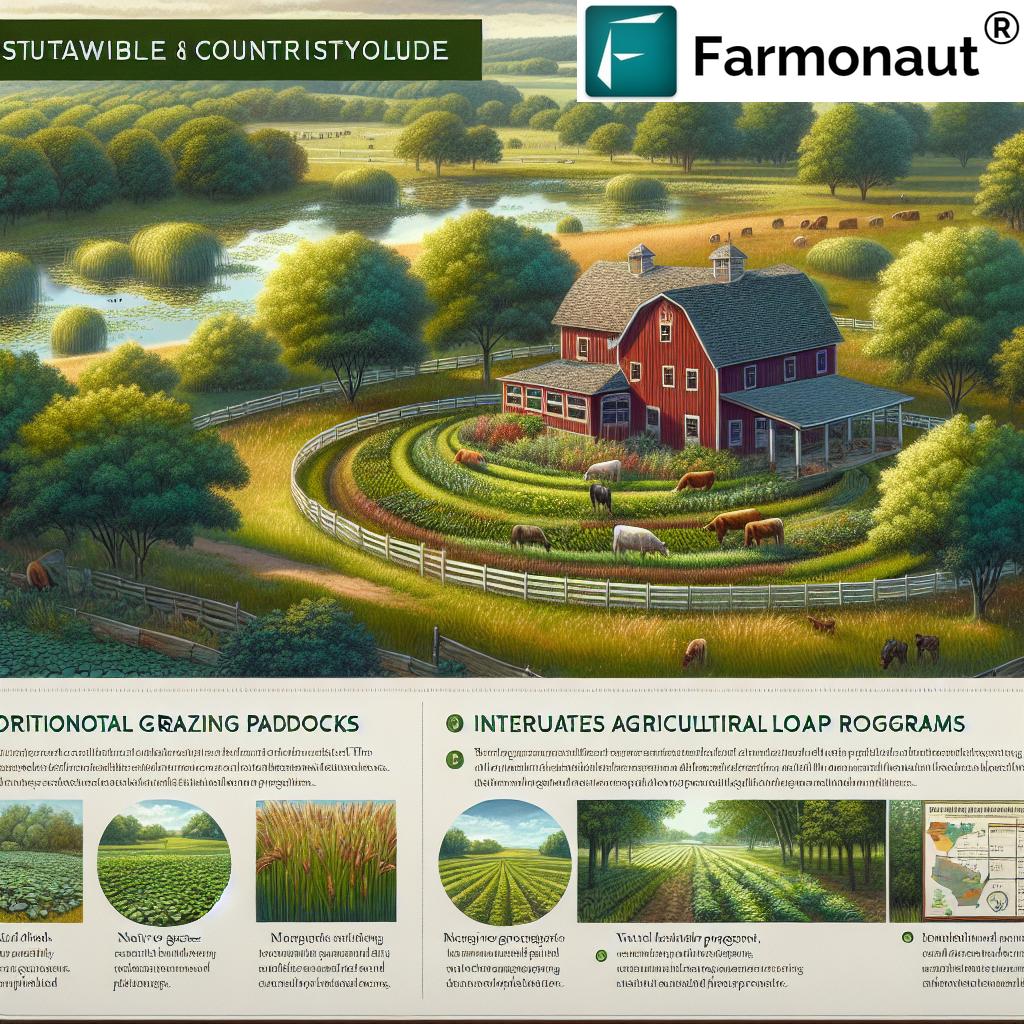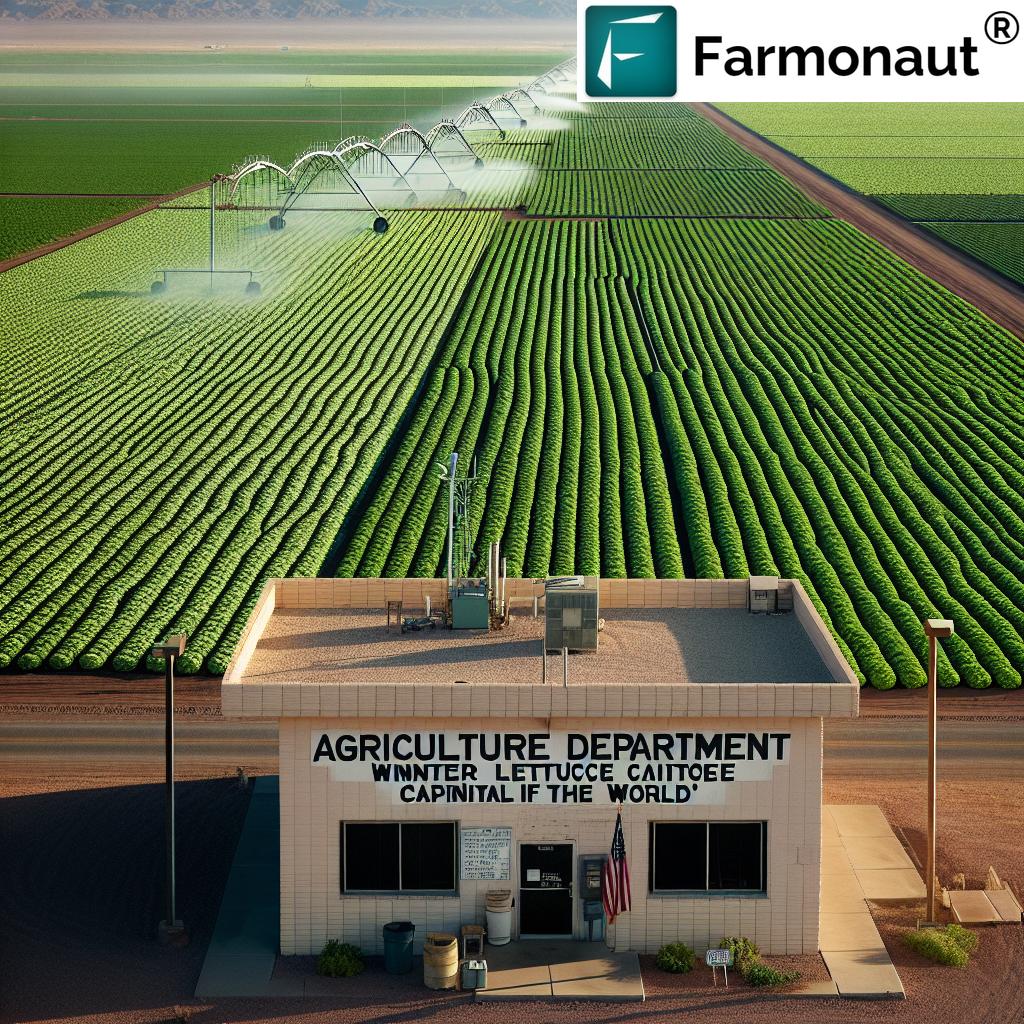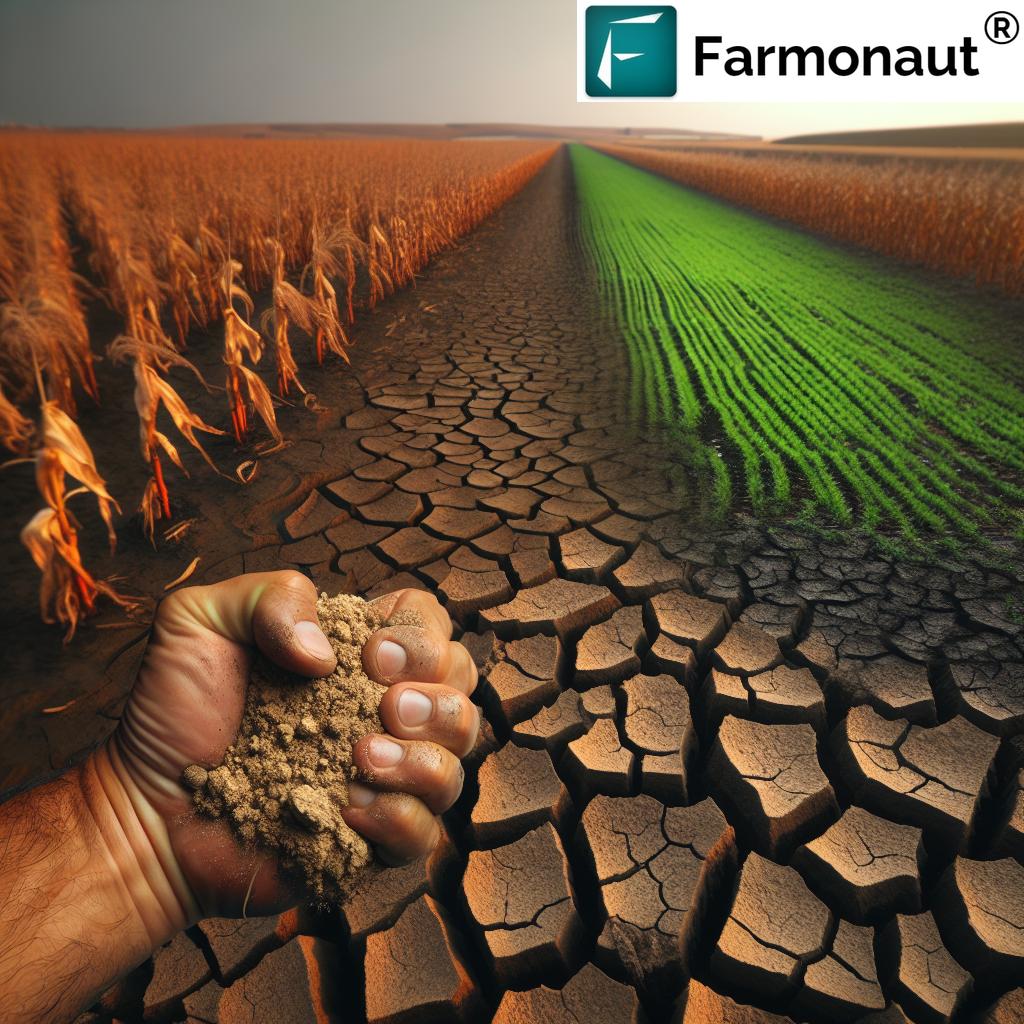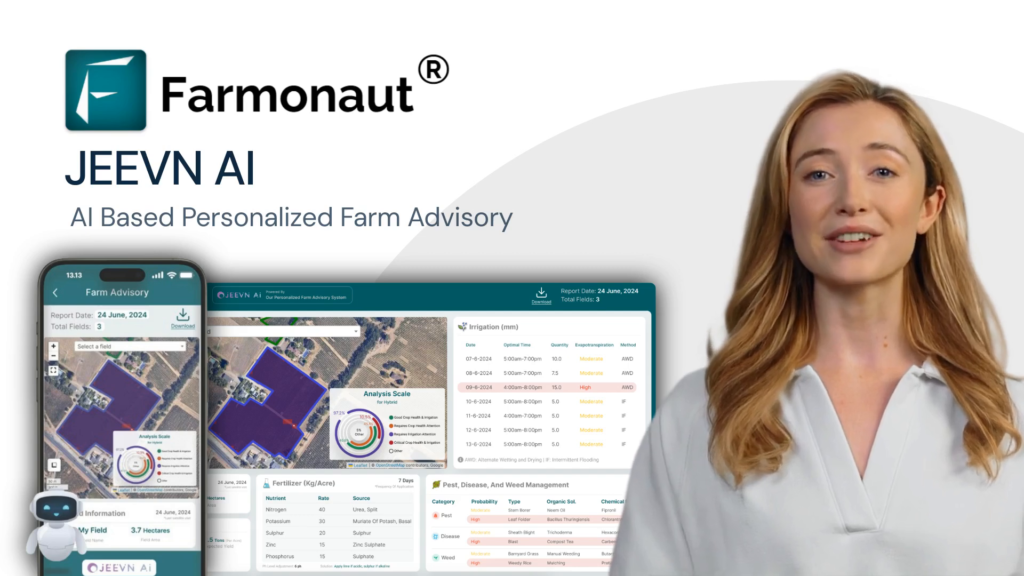Table of Contents
- Introduction: USDA’s Role in Sustainable Agriculture in Wisconsin
- Wisconsin Sustainable Farming Trivia
- USDA Conservation Programs for Wisconsin Farmers
- USDA Conservation Programs Supporting Sustainable Farming in Wisconsin
- USDA Agricultural Financial Assistance and Loan Programs
- Support for Beginning Farmers in Wisconsin
- USDA Forestry and Forest Landowner Resources
- Marketing & Rural Development Grants and Initiatives
- USDA Climate Smart Agriculture Initiatives & Recent Policy Developments
- Farmonaut: Precision Tools Supporting Sustainable Agriculture
- Farmonaut Subscription Options
- FAQ: USDA & Sustainable Agriculture in Wisconsin
- Conclusion: Cultivating a Sustainable Future for Wisconsin Farmers
USDA Programs: Boost Sustainable Farming in Wisconsin
Sustainable farming in Wisconsin is thriving, thanks in large part to the USDA and its comprehensive suite of support programs for farmers, ranchers, and forest landowners. Through a robust offering of conservation programs for farmers, agricultural financial assistance, rural development grants, and climate smart agriculture initiatives, the United States Department of Agriculture empowers producers to enhance productivity, promote stewardship of natural resources, and secure their economic viability—especially in regions like Wisconsin where sustainability is critical for both the land and local communities.
This blog provides a comprehensive exploration of core USDA programs—from Conservation Reserve Program (CRP) and Environmental Quality Incentives Program (EQIP) to forestry initiatives and technical guidance for producers—spotlighting their relevance and localized benefits for Wisconsin’s agricultural sector.
As Wisconsin continues to face new economic challenges, shifting market dynamics, and environmental uncertainties, these diverse USDA initiatives remain the backbone for sustainable agriculture—offering solutions for soil health improvement, carbon sequestration, commodity stabilization, and more. Join us as we break down these programs, share tips for leveraging them, and discuss emerging policy impacts facing Wisconsin’s farming communities.
USDA Conservation Programs for Wisconsin Farmers
Wisconsin’s agricultural sector is a vibrant tapestry of dairy, crop, and forestry operations that depend on healthy soils, clean water, and effective land management practices. That’s why conservation programs for farmers spearheaded by the USDA are critical in this region. These initiatives focus on preserving natural resources, enhancing soil quality, optimizing water use, and providing financial assistance and technical guidance for implementing sustainable practices.
Core USDA Conservation Programs Supporting Wisconsin’s Sustainable Farming Practices
-
Conservation Reserve Program (CRP):
CRP addresses soil erosion, water quality, and wildlife habitat restoration—all crucial for farm sustainability in Wisconsin’s diverse landscapes. It compensates landowners for converting environmentally sensitive agricultural land into vegetative cover.
Learn more about CRP.
-
Environmental Quality Incentives Program (EQIP):
EQIP provides direct agricultural financial assistance and technical guidance for producers in Wisconsin, enabling them to adopt environmentally beneficial practices like managed rotational grazing, prescribed grazing systems, cover cropping, and soil health improvement.
Explore EQIP program details.
-
Conservation Stewardship Program (CSP):
CSP is designed to help farmers maintain existing conservation systems and adopt additional sustainable practices. Through financial incentives, CSP supports comprehensive farm management plans that keep Wisconsin’s farmland productive for generations.
About CSP and stewardship programs.
-
Agricultural Conservation Easement Program (ACEP):
ACEP aids landowners in protecting agricultural lands and wetlands through permanent easements, ensuring important areas remain viable for farming, conservation, and environmental benefits.
Details on ACEP.
-
Key conservation program objectives in Wisconsin:
- Reduce soil erosion and water runoff
- Protect surface and groundwater quality
- Restore wildlife habitat and support pollinator health
- Mitigate the impact of climate change through carbon sequestration
- Promote the use of sustainable farming practices that benefit both farm productivity and the environment
Why Conservation Programs Matter for Wisconsin’s Farmers and Landowners
Wisconsin is home to expansive dairy operations, specialty crop farmers, and vast tracts of forested land—all of whom depend heavily on the sustained health of soil, water, and ecosystems. Participation in CRP, EQIP, CSP, and ACEP helps Wisconsin farmers secure long-term profitability while bolstering resilience to weather extremes, market fluctuations, and regulatory changes.
With over 1.2 million acres enrolled in USDA conservation efforts, these programs are the bedrock of the state’s agricultural sustainability and environmental stewardship.
USDA Conservation Programs Supporting Sustainable Farming in Wisconsin
| Program Name | Description | Eligibility Criteria | Estimated Financial Assistance (USD) | Key Sustainable Practices Promoted | Environmental Benefits |
|---|---|---|---|---|---|
| Conservation Stewardship Program (CSP) | Encourages producers to maintain and enhance existing conservation systems and adopt additional sustainable practices. | Producers who have addressed resource concerns on their operation; commit to additional conservation practices. | $18-$40/acre/year (Wisconsin avg.) |
Comprehensive conservation planning, soil health improvement, nutrient management, integrated pest management, wildlife habitat establishment. | Increased biodiversity, improved water and air quality, habitat restoration, carbon sequestration. |
| Environmental Quality Incentives Program (EQIP) | Offers financial and technical assistance for implementing conservation practices that improve soil, water, and related resources. | Ag producers who implement approved conservation activities on eligible lands. | Up to 75% cost share; avg. $8k–$45k/project |
Managed rotational grazing, cover cropping, buffer strips, irrigation efficiency, prescribed grazing systems. | Reduced erosion/runoff, water conservation, nutrient cycling, habitat restoration, enhanced resilience. |
| Conservation Reserve Program (CRP) | Provides annual rental payments and cost-share for landowners who convert environmentally sensitive land to vegetative cover. | Private agricultural landowners with eligible land subject to erosion or environmental degradation. | $72-$214/acre/year | Planting native grasses/trees, wetland restoration, pollinator habitat creation, grassed waterways. | Soil erosion control, improved water quality, wildlife habitat restoration, carbon storage. |
| Agricultural Conservation Easement Program (ACEP) | Protects working agricultural lands and wetlands through conservation easements. | Farm, ranch, and forest landowners willing to place conservation easements to prevent development. | Up to 75% of easement value (farmland); 100% for wetlands |
Wetland/grassland restoration, permanent land conservation, pollinator corridors, habitat improvement. | Long-term habitat protection, improved water retention, biodiversity, prevention of land conversion. |
| Regional Conservation Partnership Program (RCPP) | Leverages partnerships to address regional conservation challenges through targeted projects. | Eligible producers collaborating with qualified partners (NGOs, local gov’t, etc.) | Varies by project scope and partnership ($100k+ to $3M+) | Watershed management, innovative climate solutions, multi-farm habitat projects. | Landscape-scale improvements, watershed health, adaptive resource management. |
USDA Agricultural Financial Assistance & Loan Programs for Wisconsin Producers
Achieving economic viability in farming, especially in Wisconsin’s dairy sector and specialty crop production, often requires reliable financial support to weather market volatility and climate-driven risks. The USDA addresses these needs via multiple loan programs, grants, and emergency assistance options that empower farmers to invest in modern equipment, expand acreage, recover from losses, or add value to their products.
-
Farm Loan Programs: Ranging from direct loans to loan guarantees, these financial tools help Wisconsin’s farmers and ranchers purchase property, machinery, livestock, or make capital improvements. Particularly crucial for beginning, minority, and underserved farmers, these programs improve access to funding that strengthens their operations and supports expansion.
USDA Farm Loan Programs details.
-
Value-Added Producer Grants (VAPG): VAPGs empower Wisconsin producers to develop, market, and diversify their agricultural products—like cheese, yogurt, organic flours, specialty meats, or processed vegetables—improving profitability and competitiveness locally and beyond. These grants fuel agri-business innovation and job creation across rural Wisconsin.
About VAPG and value addition.
-
Emergency Commodity Assistance Program: When commodity prices drop or natural disasters threaten farm income, this timely USDA program ensures producers can weather the storm—literally and financially.
Explore Emergency Assistance details.
Expanding Market Access and Resilience for Wisconsin Farmers
- Agricultural loan programs offer stability—and opportunities—for both established farms and new entrants.
- VAPG supports farmers in Wisconsin to diversify markets and add economic value beyond commodity sales.
- Emergency assistance helps farm operations stay afloat after climate or economic shocks.
Access to these resources can make all the difference for farms striving not just to survive, but to thrive, as Wisconsin’s agricultural sector faces increasing market competition and environmental unpredictability.
Satellite-Powered Financial Access with Farmonaut
For agricultural producers and financial institutions in Wisconsin, Farmonaut’s Satellite-Based Crop Loan & Insurance Verification service offers a technology-driven approach to streamline loan and insurance approvals. By providing remote, reliable verification of crop area and health status, we help farmers access funds faster and reduce fraud risk for banks and insurers.
Benefits include:
- Accelerated approval for critical agricultural loans
- Transparent and secure data for both producers and lenders
- Improved accuracy and reduced manual field visits
Learn how satellite verification transforms crop lending in Wisconsin >>
Support for Beginning Farmers in Wisconsin
Wisconsin’s new and aspiring farmers often encounter significant hurdles—access to land, knowledge, capital, and resources. Recognizing this challenge, the USDA offers targeted initiatives such as the Beginning Farmer and Rancher Development Program (BFRDP) to cultivate the next generation of sustainable agricultural producers.
-
Beginning Farmer and Rancher Development Program (BFRDP): Grants are awarded to organizations that deliver educational tools, technical guidance, and mentoring for those new to farming or ranching in Wisconsin. The program focuses on practical skills, business planning, and sustainable best practices, ensuring long-term farm success and stewardship.
More on BFRDP support.
These educational and economic resources are vital to sustaining Wisconsin’s rural communities and keeping agricultural traditions alive while promoting innovative, climate-resilient practices on the land.
At Farmonaut, we believe in making precision agricultural technology accessible for farmers of all backgrounds—including those just starting out. Our agro-admin application empowers producers to monitor field health, receive real-time AI advisory, and access easy-to-understand crop and resource data—laying a strong foundation for lifelong farm success.
USDA Forestry and Forest Landowner Resources in Wisconsin
Wisconsin’s vast forests play an essential role not only in timber production, recreation, and carbon sequestration but also in environmental quality, wildlife habitat, and rural economic stability. Forest landowners can leverage specialized USDA programs for sustainable management and conservation of these treasured landscapes.
-
Forest Legacy Program (FLP): Protects environmentally important forestlands through conservation easements, preventing their conversion to non-forest uses and safeguarding ecosystem integrity.
About FLP and forest conservation.
-
Healthy Forests Reserve Program (HFRP): Offers cost-share and technical support for forest restoration, biodiversity improvement, endangered species recovery, and increased carbon capture.
HFRP details and benefits.
-
Benefits for Wisconsin forest landowners:
- Incentivizes long-term forest protection and health
- Facilitates collaboration for landscape-scale conservation
- Provides economic returns without sacrificing environmental values
Farmonaut’s advanced carbon footprinting tool is designed to help agriculture and forestry operations in Wisconsin monitor, report, and reduce their greenhouse gas emissions. Our mobile and web applications support real-time tracking—enabling both compliance and proactive climate action.
Additionally, our Crop Plantation & Forest Advisory service uses satellite imagery and AI to inform sustainable land management, pest and disease risk, and resource allocation for forest owners.
Marketing & Rural Development Grants and Initiatives
Marketing support and rural economic development are cornerstones of the USDA’s mission to keep communities vibrant and competitive—especially in regions like Wisconsin, where agriculture anchors local economies. Here’s how they help:
-
Farmers Market Promotion Program (FMPP): Assists producers and farmers groups in expanding local farmers markets, food hubs, and direct-to-consumer channels, ensuring Wisconsinites have access to fresh, local produce—and farmers have more market options.
Learn about FMPP and local food marketing.
-
Rural Business Development Grants: Provides crucial technical assistance, training, and funding to launch or strengthen small rural businesses in Wisconsin, catalyzing job creation and supporting agricultural innovation.
Rural business programs explained.
- These grant and market initiatives encourage Wisconsin’s agricultural sector to:
- Diversify operations and revenue streams
- Improve local and regional food systems
- Adopt value-added and climate-smart practices for long-term resilience
USDA Climate Smart Agriculture Initiatives & Recent Policy Developments
The USDA has placed increasing emphasis on climate smart agriculture initiatives, reflecting the growing urgency to address climate change impacts across the United States—and especially for Wisconsin farmers whose livelihoods are interconnected with soil health, water availability, and seasonal weather patterns.
-
Climate-friendly practices encouraged by USDA:
- Planting cover crops, reducing tillage, and improving soil organic carbon
- Implementing nutrient management plans and water conservation techniques
- Using prescribed and rotational grazing systems
- Adopting advanced data analytics to optimize resource use
While these measures are widely promoted, experts sometimes question the long-term impact of certain approaches (for example, cover cropping’s role in carbon sequestration), as discussed in recent reports on USDA climate programs. Ongoing research, evaluation, and adaptation ensure that climate-smart agriculture evolves to deliver true sustainability and measurable results.
USDA’s responsiveness to current events—like implementing direct payments to balance trade losses from tariffs or adapting programs to address social and economic justice—demonstrates its commitment to supporting the diverse needs of farmers and agricultural communities in Wisconsin and across the nation.
-
Wisconsin dairy farmer lawsuit and program equity headlines
-
Direct payment policies & tariff loss mitigation updates.
Our blockchain-based traceability solutions are designed for Wisconsin’s producers, processors, and cooperatives seeking to authenticate their local food and fiber supply chains. By securely recording every stage from farm to shelf, we help add value and foster consumer trust in sustainable, Wisconsin-branded products.
Additionally, Farmonaut’s fleet management suite allows large-scale agricultural businesses to optimize fleet use, reduce operational costs, and improve machinery oversight—delivering key efficiencies for the state’s growing agri-business sector.
Farmonaut: Precision Technology Tools Supporting Sustainable Agriculture
At Farmonaut, we are passionate about making sustainable precision agriculture affordable and accessible to everyone—from smallholder dairy farmers in Wisconsin to large agri-enterprises and rural cooperatives. Here’s how our platform aligns with and enhances the goals of USDA’s conservation and development programs:
- Satellite-Based Crop & Soil Health Monitoring: We use multispectral satellite imagery to provide real-time insights into vegetation vigor (NDVI), soil moisture, and resource allocation—equipping farmers to act quickly on issues and optimize inputs.
- Jeevn AI Advisory: Real-time, AI-driven recommendations for pest and disease management, irrigation, and weather risk mitigation, tailored to each user’s unique field conditions.
- Carbon Footprint Tracking: Accurately monitor and manage emissions—helping agricultural and forestry operations in Wisconsin stay ahead of regulatory requirements and meet climate goals.
- Blockchain Product Traceability: Full transparency and origin tracking for Wisconsin-grown products, adding market value and strengthening consumer trust.
- Resource and Fleet Management: Powerful web/mobile tools for scheduling, vehicle tracking, and machinery safety.
-
Try our platform today:
Farmonaut Web & Mobile Apps
|
Carbon Footprinting
|
Product Traceability
Farmonaut Subscription Options
We offer transparent, flexible subscription plans for farmers, agribusinesses, and government bodies—all accessible through our intuitive web or mobile apps. Explore plan details and find the perfect option for your operation below:
FAQ: USDA & Sustainable Agriculture in Wisconsin
Conclusion: Cultivating a Sustainable Future for Wisconsin Farmers
Wisconsin’s agricultural landscape is shaped by the land’s unique qualities—and by our shared stewardship of its resources.
Through diverse and comprehensive USDA conservation programs, agricultural financial assistance, climate smart agriculture initiatives, and rural development grants, Wisconsin farmers, ranchers, and forest landowners have the essential tools for building long-term economic viability, ecological balance, and market resilience.
As policy, climate, and economic challenges evolve, these USDA initiatives—alongside advanced digital solutions like those provided by Farmonaut—will remain central to supporting sustainable farming practices in Wisconsin. Together, we can ensure a future where the state’s beloved farms, forests, and rural communities not only survive—but thrive.
Interested in leveraging satellite technology, AI-powered advisory, carbon tracking, or blockchain traceability for your farm? Explore our:
-
Mobile/Web Apps and Platform Features
-
Carbon Footprinting for Farms & Forests
-
Blockchain Traceability Solutions
-
Agro-Admin Management Suite
By bringing together USDA program resources and precision ag technology, Wisconsin can set the standard for climate-resilient, diverse, and community-oriented rural development. Let’s keep growing—sustainably, profitably, and together.















